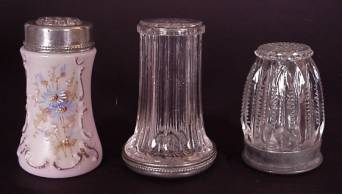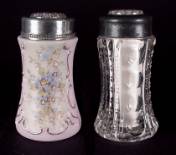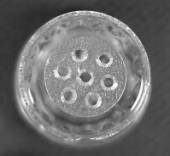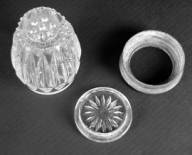Parker Wave Crest Salt Shakers
PARKER Non-Corrosive Salts by C.F.Monroe Company
The C.F. Monroe Company is known to most collectors for their beautiful line of Wave Crest, Decorated Opalware. They were also known for the Kelva and Nakara lines as well as cut glassware. Catalog reprints (1900-01 and 1902-03) have shown that they were the sole manufacturers of patented salt shakers called “Parker Non Corrosive Salts”.
There were four basic styles shown for these shakers. The following pictures show them. A crystal version of the Parker B salt was just found. Since this completed the identification of the four basic types, it led to a patent search resulting in a somewhat surprising outcome. Please see below for a detailed description of the Parker salts and the Bruce’s story of the results of their research.
These rare Wave Crest shakers were just found in with a group of other shakers. They had no tops and were sitting upside down.
by Bob & Carole Bruce
We have been avid collectors of Victorian Salt Shakers for over thirty years. We have always been fascinated with the beauty of the glassware of the Victorian era. When we think of that era and the “primitive,” by today’s standards, materials and processes that the artists had at their disposal, we marvel at the wonderful glassware they were able to produce. The C F Monroe Company produced some of the finest and most beautiful glassware of the Victorian era. Known to most collectors for their Wave Crest line, they also produced the Nakara, Kelva, and cut glass lines. This beautiful glassware can be seen in the excellent comprehensive, now out of print book, by Wilfred Cohen, Wave Crest, The Glass of C F Monroe. (If one is lucky enough to find one.) Catalog reprints have been found and published which document much of their glassware. It is unusual to find clear pressed glass attributed to C F Monroe, as they were primarily known as decorators, buying their blanks from Mt Washington Glass Company and others.
This article is about a recently found salt shaker that has not, to our knowledge, been previously documented. In the 1900-1901 catalog reprint by Elsa Grimmer, Parker Non-Corrosive salts are shown. The catalog shows three different Parker salts, and states that C F Monroe has sole rights to manufacture and decorate this patented design. These are known as the Parker style A, Parker style B, and the Parker style C salts. The uniqueness of these salt shakers is that a glass insert is used to cover the salt shaker and is held in place with a metal ring. The metal does not come in contact with the salt, thereby preventing corrosion of the soft metals used during that era. Collectors of Victorian salt shakers know corrosion to be a significant problem, as many tops did not survive. The 1902-1903 Catalog was reprinted by Wilfred Cohen and shows the Parker Style A salt and the Style C Salt. However, the Style B salt was replaced by a crystal salt identified as Parker Salt 17 – Crystal.
We had always assumed that this rather unique different design was the source of the patent. But upon further research we found that this was not the case. We are fortunate to have found the Parker style A salts some time ago. They are shown in Cohen, page 30, and called extremely rare. They are opalware, beautifully decorated in classic Monroe decor. We also had found the Style C salt in crystal. It is pressed glass, probably intended to look like more expensive cut glass.
The Style A salt has the customary opening at the top. The Style C salt has the opening at the bottom. Until recently, to our knowledge, only one of the Style C salts has been found in decorated opalware. We saw it several years ago at our AGSSSC Annual Convention. Then, we found the “special find” pair pictured above
We also just recently found a pair of the Style B salts in crystal. It was of course, an exciting find for us, as we have never seen one nor heard of its existence. Like the Style C salts we have, this one is clear pressed glassware.
Upon finding the Parker Style B salt, we decided to see if we could find the patent. We were able to find the patent by searching those patents with an issue date of July 4, 1899. Each of the style B and C shakers has the patent date on the glass body. The style A shaker has the patent date on the insert. The patent was issued to Edmund A. Parker of Meriden, CT, number 628,030. The Parker Style C salt is used in the illustration. To our surprise, the patent was for a technique to produce a shaker with holes in the glassware in a manner that was economically feasible. The concept of preventing salt in contact with the metal was not the source of the patent but the technique to put holes in the glass to dispense the salt was the source of the patent. The technique enabled this design with a cost effective way to produce the shakers. The “novel approach” was done via the glass plunger as the shaker was pressed. Different size holes for salt and pepper were achieved by grinding the top more or less, as the holes were tapered. The alternate technique of drilling the holes was a multiple step process and resulted in chipping and excessive breakage.
Upon careful review of the catalog reprints, it appears that the Parker A, B and C designations were for the decorated opalware versions of the Parker salts. The A style was issued as a crystal salt and named number 17, style C was number 18 as crystal and the Parker B was apparently number 19. So, for future reference we should designate them as six separate salts, Parker A, B, C, 17, 18, 19. It is obvious that the crystal salts are not exactly the same as the opal salts, but the shape is basically the same.
The accompanying pictures show the three crystal Parker salts and the Parker A salt. Both the Parker 17 and 19 salts are shown with the bottom ring removed to show the inserts. Also shown is the top of the Parker 19 salt. Looking carefully one can see that the holes are tapered.
Although this was an exciting find, and we should be satisfied with our recent purchase, we now find we are more challenged to find opalware decorated salt shakers, the Parker B and C types. But that is what makes collecting so much fun and exciting.

Excerpt of Patent for Parker Salt. (above)
Patented by Edmund Parker on July 4, 1899.
Patent Number 628030.

Catalog reprint for Parker Salts: Page from Elsa Grimmer’s
1900-1901 Wave Crest Catalog Reprint.









